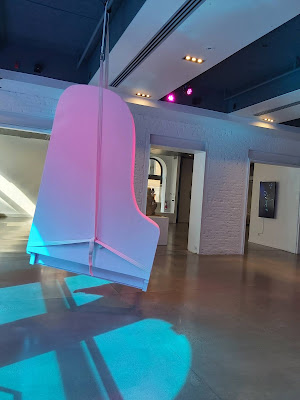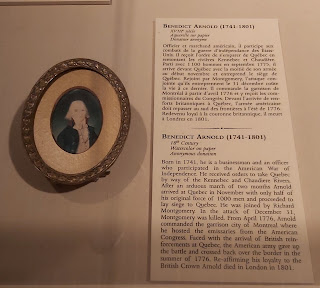In July, we travelled to Montreal, without the trailer. We stayed in a hotel downtown close to everything. We walked everywhere, up and down the hills that Montreal is located on. Montreal is a very interesting place, especially the Old Port district. There is so much history that you have to take a guided tour. A walking tour is the best.
Many gems are just around the corner such as the
bronze statue called Les Chuchoteuses (The Gossipers)
located along Rue Saint Paul. I really like this statue.
It shows the comfort and familiarity that the women share.
Transportation: On many streets there are racks of rental bikes available to people any time of the day. Biking is a popular mode of transportation not only in Montreal but in Quebec generally. Bike paths are abundant and have been designed to protect the cyclists from other traffic.
One of the large bike racks in Montreal
just next to our hotel.
Art: As in most cities, art plays a role in its identity. Montreal is no exception. There is art throughout the city; on the streets, in the parks and on and in the buildings.
This is art? Pianos hanging from the ceiling in
one of the art galleries
Art is on top of the roof of a cooling shelter.
Art at the waterfront
Art in an art gallery
Moving art: two entwined bodies bobbing in water
Al enjoying a movie about the Space Station using virtual reality goggles. It was an interesting
feeling sitting in a chair and looking around and seeing 360 degrees inside the space station.
Architecture: The architecture of Montreal demonstrates the legacy of two successive colonizations by the French, British and the close presence of modern architecture to the south. Many historical buildings retain their facades, particularly the 19th Century headquarters of all major Canadian banks on Saint Jacques Street.
This structure brings back memories. As a child, I remember seeing this housing complex in person in 1968: HABITAT 67, or simply Habitat, is a model community and housing complex in Montreal, designed by architect Moshe Safdie. It was built as a pavilion for Expo 67, the World's Fair held from April to October 1967. Habitat 67 is widely considered an architectural landmark and one of the most recognizable buildings in both Montreal and Canada.
What! The Beer Company had a bank? Who would have thought! Reading the history of the
Molson Family you see that they were involved in many parts of the community other than the brewing of beer, such as supporting a Montreal hospital, a railway and hockey both in Montreal and Toronto. In 1855, the Molson family’s contributions to Canadian banking began with John Molson Jr. and his brother founding the Molsons Bank to help a growing economy flourish. It later merged with the Bank of Montreal.
Back in the 1800's the architecture of the buildings
was quite intricate as you can see from this and the following photos
Below are photos of architecture that you don't see in any new builds. The craftmanship of the work is outstanding. We enjoyed our tour of the past looking at the buildings of Old Montreal.
The Château Ramezay is a museum and historic building on
Notre Dame St. in Old Montreal opposite the City Hall (hôtel de ville). Built
in 1705 as the residence of then-governor of Montreal, Claude de Ramezay, he
and his descendants lived there until 1775 when it became the Canadian
headquarters for the Continental Army (of the 13 American colonies in British
America) after they seized Montreal. The
British were able to recapture Montreal in 1776 and the Château again became
the British governor’s residence until 1878 when it was used as a Faculty of
Medicine for the Université de Montreal. It has been a historical museum since 1894.
We
enjoyed the numerous exhibits in the building which were very informative about
the era when the French and British were fighting for control of North America
as well as the turmoil south of the border during the Revolutionary War (1775-1783).
Iconic Canadian items: the beaver, a canoe
and ceintures fléchées (woven sash).
There were many portraits of women throughout the building.
They must have had a large role in the society of the day to display so many.
Intricate woodwork is throughout the house.
Benedict Arnold (1741-1801) - It was interesting to read the blurb that accompanied this small portrait of Arnold, which makes no mention of his defection from the American Continental army to the British side of the conflict in 1780 during the Revolutionary War (1175-1783). In the U.S., his name is synonymous with "traitor".
 |
| The purpose of this statue is the object of much speculation: Was it the sign for a tavern frequented by sailors, or a business that sold shipping equipment? According to the artist's statement, this sculpture was made for a tobacco merchant. This type of three-dimensional advertising was very popular in the 19th century. |
 |
| Tobacconist's Signboard: Since they were the first to grow tobacco in North America, native Indians naturally became a favourite symbol of tobacco vendors. Inspired by manufactured goods catalogues from the United States, this Amerindian holding cigars is in keeping with the trend of painted or sculpted commercial signs, which began in the 1850's. |
 |
| Montreal's coat-of-arms: Jacques Viger gave Montreal its coat-of-arms in 1833. The motto, Concordia Salus - Prosperity Through Harmony expresses the desire for the harmonious co-existence between the French, English, Scots and Irish; Montreal's main cultural groups in the mid-1800's. The coat-of-arms contains emblems of these groups and the modern Montreal flag contains a stylized version of the original coat-of-arms. |
Early transportation
Everyday items were on display to show the the utensils used
during the years when the chateau was alive with activity
Because of the ever-present risk of attack, the Governor's residence had to be fairly self-sufficient and there was an extensive garden behind the building to supply food for the kitchen as well as space for garden parties. The current garden is much smaller than it was in the 18th century, but it still contains smaller sections containing fruit trees, crops and flowers similar to what would have been cultivated in those times.
A fountain in the garden
The garden behind the maison (house) was supposed
to be quite unique but I did not see it as
anything special. I was more interested in the bees.
SOS Labyrinthe: This is an indoor attraction at the Old Port in a 105-year old hangar which is an indoor 2-km maze. There is a mission to find four "treasures" of the longshoremen (les debardeurs) while avoiding the obstacles and traps. As you find each treasure, a plaque describes historical facts related to Montreal, its river or its harbour. A number of posters tell the stories behind these treasures, allowing you to grasp the historical significance of these little known facts.
Each person starts with a card that is time stamped with their starting time When you discover each treasure you stamp your card and continue until you have found all the treasures and then you head for the time clock to stamp your finish time.
 |
| Snowballs, The Whale, The Ice Tongs, The Stuntman |
The maze!
Lights, sparkles, bridges and tunnels are a part of the maze
Oasis Immersion: This is a unique type of museum. While most museums have displays with info boards to read and often some multi-media exhibits, Oasis takes this a step further with an immersive experience.
A sign within the space defines the experience: Oasis immersion is a sort of immersive magazine where spirited minds come to refuel and escape the routine of everyday life. There, they find fresh new ideas and inspiring works. It's a place to rethink society and its foundations through the prism of optimism. The mood is upbeat, energizing and inspiring, one that calls to action. Light and movement are at the heart of the experience and this is reflected in their logo. The rays of the light spectrum criss-cross, reminiscent of the rich yet playful multi-sensorial projections of light, sounds, colours and themes, while the esthetics of the logo draw on contrasts and refinement.
The project was developed in an old 2,000 m2 (over 21500 ft2) bus terminal which was then equipped with 105 laser projectors and 119 surround-sound speakers to create spectacular immersive exhibitions showcasing inspiring people, ideals and places of our times.
Moving exhibits are all around you, on the floor, walls and ceiling
A very interesting experience in seven different rooms and themes.
Round and round we go...
Of course we could not leave Montreal without going on the Ferris Wheel (La Grande Roue De Montreal). We had a lovely view of the City.
The tourist photo.
They get you every time!
The following photos were taken from the top of the Ferris wheel:
Another remnant of Expo '67
The train that goes around the Ferris wheel
View from below!
Montreal was a great city to visit. We explored Old Montreal and learned a lot about the history of not only Montreal but also Quebec and Canada. We walked everywhere, ate good food, experienced various technical exhibits and played. Every city has their hidden treasures and we enjoyed finding some of the ones Montreal has.


































































No comments:
Post a Comment